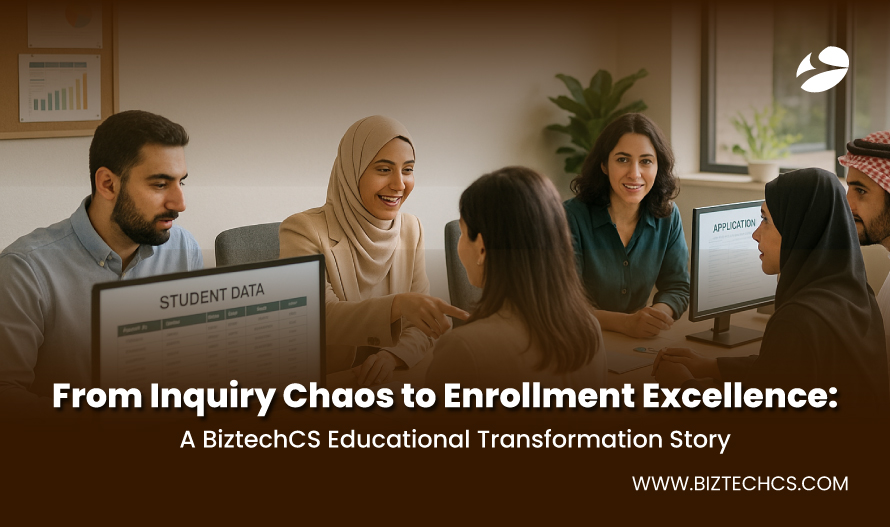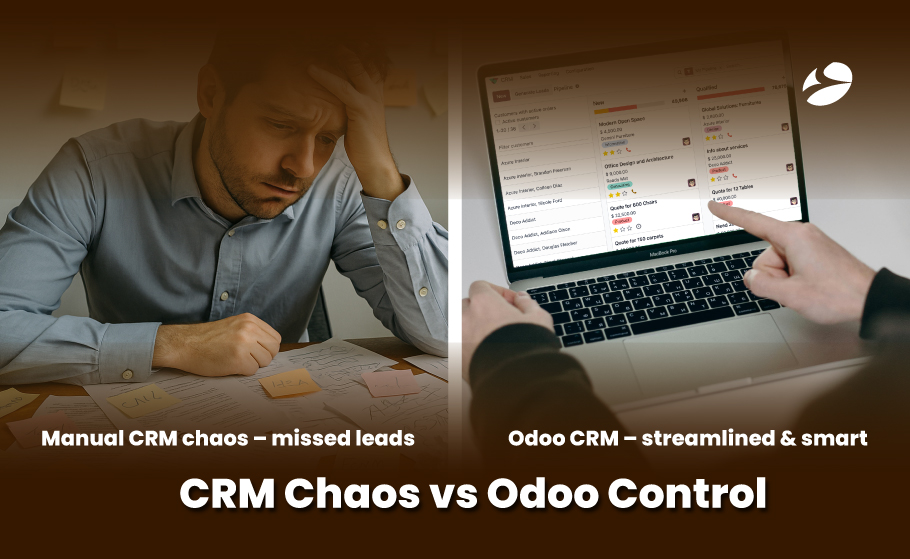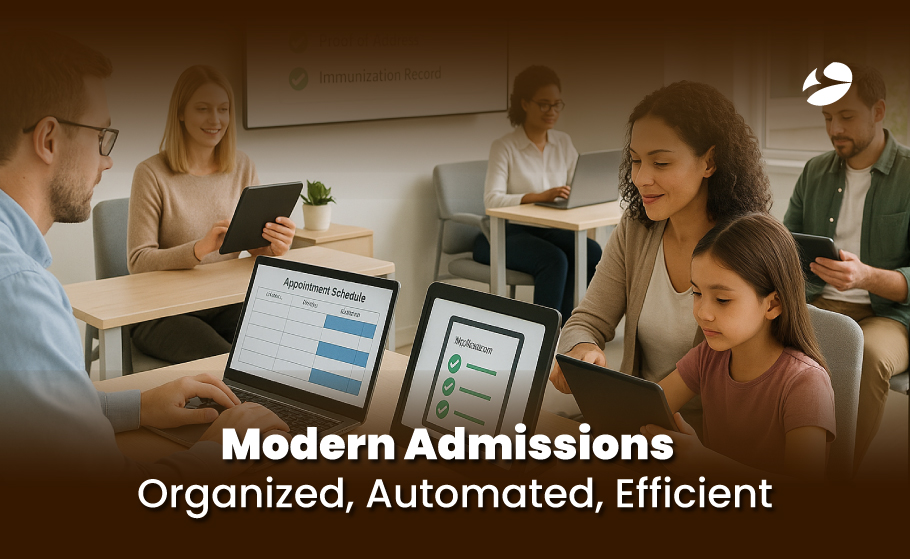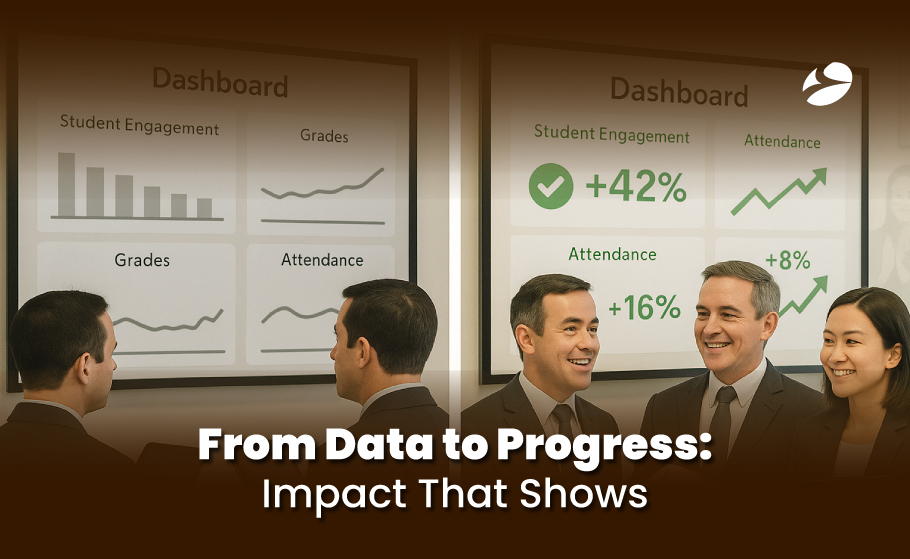From Inquiry Chaos to Enrollment Excellence: A BiztechCS Educational Transformation Story
5 min read
5 min read
Table of Content

When Dr. Sarah Al-Mansouri, Principal of Dubai International Academy, outlined her school’s enrollment challenges during a recent consultation, a familiar pattern emerged: inquiry volumes were climbing, but actual enrollments weren’t keeping pace. This trend isn’t unique to one school. Across the GCC—from Kuwait’s premier institutions to the UAE’s most competitive academies—many schools face the same issue.
Despite education landing pages showing a median conversion rate of 8.4%, significantly higher than the 6.6% cross-industry average, most schools fall well below this mark. Often, the root cause lies not in academic offerings but in the admissions experience itself. Families today expect quick, clear communication. When they don’t receive it, even high-intent inquiries can disengage.
A deeper look into internal processes reveals the problem: many admissions teams are still relying on manual methods—personal reminders, handwritten notes, and memory. In an analysis of over 40 educational institutions across the GCC, 87% were found to be operating without automated follow-up systems at the start of engagement. This manual approach contributes directly to a 34% drop in conversion rates compared to schools that use automation.
To counter this, leading institutions are now rethinking how inquiries are handled—not just by speeding up responses but by building smart workflows tailored to the prospective family’s journey. One effective strategy begins before any CRM customization takes place: mapping every inquiry source, whether it comes via WhatsApp, phone call, walk-in, or website form. Each lead is then scored and categorized to ensure consistent follow-up based on urgency and intent. This process ensures no channel is overlooked, and that every family receives timely, appropriate attention.
For instance, using Odoo-powered workflows, schools can route urgent mid-term transfer inquiries to same-day follow-up paths, while families exploring options for the next academic year enter nurturing campaigns that offer well-timed invitations for campus visits—aligned with key decision points in the academic calendar.
Ultimately, academic excellence may bring families to the door, but operational excellence is what keeps them engaged.
A parent submits an inquiry form at 9 PM, expecting a response by morning. However, instead of entering a centralized CRM, the form ends up in a shared Gmail inbox, which three staff members inconsistently monitor.
Another parent calls during their lunch break, and their information is entered into an Excel sheet—if someone remembers to do it. A family walks in for an impromptu campus tour, and their details are recorded in a paper register that may never be digitized.
This kind of fragmented lead capture isn’t just inefficient—it poses a direct threat to conversion rates. With higher education having the highest average cost per lead across all industries—$982 for both paid and organic—it becomes imperative to maximize every single opportunity. When each inquiry represents nearly $1,000 in marketing effort, losing leads due to inconsistent tracking is simply not sustainable.
In such cases, one of the first steps we recommend is evaluating how seamlessly your marketing and admissions systems communicate. A key question to ask is: Can your current system identify which marketing campaign generated the most walk-ins this week? If the answer is no, there’s a clear gap in attribution and visibility—one that can be bridged with the proper CRM configuration.
Using Odoo for Schools, it’s possible to integrate marketing attribution directly into the admissions workflow. Every touchpoint—whether it’s a Google Ads click, a Facebook form, or a spontaneous campus visit—can be captured with its source, thanks to unique tracking codes. Leads from different channels can be scored based on engagement and intent. Organic visitors, paid campaigns, and social referrals are each tagged for clearer reporting and analysis.
This level of integration enables schools to do more than just track performance—they can take action on it. For example, when a CRM reveals that Instagram campus tour videos are driving more qualified leads than other platforms, or that Google Ads consistently attract families more likely to enroll, teams can quickly reallocate budgets to optimize results.
The outcome? Smarter marketing investments, better follow-up workflows, and ultimately, stronger enrollment figures. Schools that adopt this integrated approach often see up to a 23% reduction in cost per enrolled student, along with measurable increases in total enrollment—all without increasing their marketing spend.

The first 48 hours of any BiztechCS educational implementation focus on one thing: immediate pain relief.
Our Odoo CRM and website integration approach for schools connects every digital touchpoint to a unified admissions CRM. This means inquiry forms, walk-in logs, and callback requests are automatically captured as structured lead records. /
But technology alone isn’t enough. Without the proper methodology, even the best tools fall short.
That’s why we built a custom lead funnel. One that reflects how families make enrollment decisions:
During one session, the Admissions Director asked, “Can I see follow-up status by counselor?”
We configured a dashboard that provided the answer to just that. It shows visibility by user, funnel stage, and inquiry source. Suddenly, accountability wasn’t a manual effort—it became automatic.
BiztechCS Consultant Tip:
Education CRMs fail when they mimic corporate sales funnels. Family enrollment journeys are emotional and research-heavy. They involve multiple decision-makers. Your CRM stages need to reflect this psychology, not just administrative checkboxes.
Now for the key transformation question:
How many families are stuck in your “Information Sent” stage because no one followed up within 24 hours?
Here’s the reality.
Our pre-implementation audit uncovered a sobering trend. 67% of families who received a prospectus—but didn’t get personal follow-up within 48 hours—dropped off the radar. These weren’t cold leads. They had shown genuine interest by requesting detailed information.
The breakthrough came with automation.
We implemented stage-based triggers that ensure consistent engagement. When a lead moves from “New Inquiry” to “Information Sent,” the system now:
This eliminated the “follow-up gap” that had been costing both schools over 40 qualified enrollments per year.
More importantly, families now experience consistent, professional engagement.
Not just automation—but human connection, delivered at the right time, with the right message.
That’s how technology serves education, not replaces it.
The global education ERP market was valued at USD 16.42 billion in 2023.
It is projected to grow at a CAGR of 21.98% from 2024 to 2030. This rapid growth highlights the urgent need for institutions to have systems that link marketing investments to enrollment outcomes.
We implemented Odoo CRM for several schools in the UAE and the GCC region. This setup enabled UTM tracking across every digital channel. From Google Ads promoting Open House events to Facebook posts highlighting student achievements, and Instagram stories showcasing campus life, every click was tracked. Each inquiry revealed its source and the medium through which it was made. Marketing went from guesswork to measurable results.
We also introduced a lead scoring algorithm customized for educational institutions. It considers multiple variables:
Urgency Factor: Families inquiring mid-term score lower than those looking for immediate enrollment.
Engagement Quality: Actions like downloading the prospectus and attending a virtual tour increase the score.
Geographic Proximity: Local families convert three times faster than expatriate relocations.
Grade Level Demand: Inquiries from Reception and Year 1 score higher due to limited seating availability.
Marketing Attribution Insight: Campaign ROI is tracked and visualized to prevent wasteful spending.
At Dubai International Academy, the CRM showed that Google Ads were generating 40% more qualified leads than Facebook. With this insight, they shifted their ad budget. Conversions improved almost immediately. That’s the power of proper marketing attribution built into a well-configured Odoo CRM.
According to Unbounce’s 2024 Education Conversion Report, email has the highest conversion rate at 14.1%. Paid search comes next at 7.3%. Our CRM system uses this data to help schools focus on channels that convert best.
Then came the next challenge: Which marketing channel brings in families with the highest lifetime value (LTV)?
Answering that question changed how schools viewed ROI. It wasn’t just about enrollments anymore. It was about retention and long-term value. Our analysis revealed that families acquired through referral programs had 89% higher retention rates. They also delivered 156% more LTV than those from paid ads.
Here’s how we’d have approached it:
Every enrolled student was tagged with their original acquisition source. We then tracked each student through to graduation. The data was revealing. Families from Google Organic Search stayed an average of 4.2 years. Instagram-acquired families stayed just 2.8 years. Referral families, however, stayed an average of 5.1 years and referred 2.3 other families on average.
This insight reshaped marketing strategies. Instead of chasing volume with high-cost Facebook ads, schools began investing in referral programs and SEO. The outcome? A 34% increase in high-LTV family acquisition and a 28% reduction in overall marketing costs.
Now, Odoo automatically calculates projected LTV for every new inquiry. Admissions teams know exactly where to focus their time and effort.
If you’re curious about how your school’s marketing attribution measures against GCC regional benchmarks, BiztechCS offers complimentary enrollment funnel assessments. Sometimes, the most valuable insights come from understanding what isn’t being measured.

The final phase of enrollment often becomes a bottleneck. Campus visits, interviews, and document collection can quickly overwhelm even experienced admissions teams.
To address this, BiztechCS implemented event-based automation to streamline every touchpoint. Campus tours are now automatically scheduled based on family availability and grade-level groupings. Interview reminders go out 48 hours in advance via SMS and email. Document submission is tracked through a digital checklist, with automated follow-ups for any missing items. Assessment days are coordinated through batch scheduling for entrance exams and evaluations.
Despite these efficiencies, one persistent challenge remained: Tracking which families missed their document submissions in time—and following up before the term started. Our early data showed that 23% of families who had verbally committed never submitted the required paperwork. The culprit? Vague instructions and inconsistent follow-up.
We solved this by deploying a dynamic document dashboard. It tracks each family’s progress in real time. As soon as an enrollment deposit is received, the system generates a personalized checklist. Requirements and deadlines adjust automatically based on visa status, grade level, and term start date.
Follow-ups are no longer manual. A friendly reminder is sent seven days before the deadline. If there’s still no action, a second, more urgent notification follows after three days. If documents are still pending on the final day, the system automatically escalates the task to a personal phone call.
The results were immediate: document completion rates rose from 77% to 96%, eliminating the last-minute scramble. Instead of chasing paperwork, staff now focus on meaningful engagement with families.
With better visibility, schools now manage waitlists confidently. They know exactly how many seats may open due to incomplete applications and can optimize admissions without compromising quality. That operational discipline sends a powerful message to families—that the structure and care evident in admissions reflects the experience they can expect throughout their child’s education.
And the market reflects this shift. According to a 2024 report by Grand View Research, the global education ERP market is projected to grow from USD 16.4 billion in 2023 to USD 61.2 billion by 2030, driven by the need for integrated, end-to-end solutions over isolated point tools
(source).
At BiztechCS, we understand that education doesn’t follow fiscal calendars. Family decisions peak at emotional moments—end of term, visa renewals, relocations. That’s why your Odoo for Schools system must mirror how families actually decide. Automation is most effective when it respects the human side of education.

Numbers tell the story when operations align with outcomes. Within just one academic quarter of implementing BiztechCS’s phased Odoo deployment, one educational group saw measurable transformation across multiple fronts.
Lead response time dropped by 76%—from more than 48 hours to under 12. The first-contact success rate jumped from 34% to 89%. Follow-up completion reached a 95%+ service level agreement, a major shift from the previously inconsistent and untracked process.
Lead-to-enrollment conversions tripled across both institutions. Marketing teams gained visibility into campaign ROI, which allowed for smarter, data-driven decisions. Better lead qualification led to a 45% reduction in the cost per successful enrollment.
Operationally, administrative time was reduced by 60% through process automation. The average document collection cycle was shortened by two weeks. Parents noticed the difference—satisfaction scores increased by 40% due to quicker responses and better communication.
According to CRM.org’s 2025 report, companies that implement CRM technology can see up to a 42% improvement in sales forecasting accuracy. For schools, that translates to better enrollment predictions, accurate budget planning, and more strategic use of resources.
These outcomes weren’t just statistical wins—they reshaped how schools operate. When every inquiry is met with a professional follow-up within 12 hours, and every parent feels supported throughout the enrollment journey, schools start to shift in meaningful ways. It’s worth asking: what could your school achieve with that level of responsiveness and care built into every interaction?
This leads to a bigger question: What would your school accomplish if every inquiry received a professional follow-up within 12 hours? And what if every parent felt supported throughout their enrollment journey?
This isn’t a hypothetical scenario. It’s the real outcome we’ve delivered across more than 40 educational institutions. At Dubai International Academy, this level of operational excellence delivered far-reaching benefits. Parent satisfaction increased by 40%. Staff stress during enrollment season dropped noticeably. And the school’s reputation among the expatriate community improved.
More importantly, their enrollment conversion rate jumped from 23% to 67%. With that level of predictability, the leadership could forecast revenue confidently. They planned facility expansions ahead of demand. They hired teachers proactively—no longer scrambling after the fact.
These changes transformed the institution’s culture. Teachers spent more time educating rather than chasing paperwork. Admissions teams focused on building relationships, not just processing forms. Leadership began making decisions based on real-time data, not outdated assumptions.
That’s the power of alignment between systems and strategy. And it becomes a competitive edge that schools with manual processes simply can’t replicate.
The success stories from Kuwait and the UAE highlight a global shift in how educational institutions manage operations. In 2024, North America led the education ERP market , accounting for a 26.9% share. Europe followed with 22.1%. Meanwhile, the Asia Pacific region is expected to grow rapidly at a CAGR of 24.77% from 2024 to 2030.
This growth isn’t just about new technology. It reflects a deeper understanding among institutions: operational excellence drives better educational outcomes. When administrative workflows run smoothly, educators can focus on what truly matters—student success.
In the GCC, schools face unique challenges. High numbers of expatriate students, multiple curricula, and active government digitization programs all shape how institutions operate. These conditions require CRM solutions that are tailored to the region.
Off-the-shelf platforms often fall short. That’s where BiztechCS comes in. Our deep regional expertise ensures Odoo CRM implementations align with local regulations, cultural expectations, and day-to-day realities.
According to a 2024 announcement from Ellucian, SaaS ERP implementations have jumped by 67%. This confirms the growing shift toward cloud-based education CRMs across the sector.
Looking ahead, future-ready schools are investing in more than just today’s tools. The ,Global Education ERP Market Outlook indicates that innovations in cloud computing and AI are revolutionizing the way CRMs operate.
Features like predictive analytics and real-time data processing are now built into platforms like Odoo CRM for the education sector. Schools adopting ERP systems today are preparing for a future shaped by AI-driven learning and smarter student engagement.
Every Principal eventually faces the same decision. They can continue managing growth through manual processes that don’t scale well, or they can invest in systems that become stronger as enrollment increases.
The schools that thrive in the coming years will be the ones that make this decision early, while the operational challenges are still manageable. Waiting until it becomes a crisis is often too late.
According to research from the University of Cincinnati’s ERP Futures Summit, more institutions are now focusing on long-term strategies. They are planning to meet operational and support needs over the next seven years. This forward-thinking approach to admissions and CRM system planning is what separates thriving institutions from those stuck in reactive mode.
There are key questions every school should ask. Can your current systems show which families are most likely to enroll this term? Do you know the actual cost of acquiring each enrolled student across all marketing channels?
How many qualified families did you lose last term due to slow follow-up or poor communication? And what percentage of your admissions team’s time is spent on administrative tasks rather than building relationships?
If these questions highlight gaps in your current setup, you’re not alone. Most of the schools we work with begin in similar situations. The difference lies in recognizing that enrollment success isn’t just about offering great programs.
It’s about making it easy for families to discover, evaluate, and choose your school. The right CRM system for educational institutions can make that happen seamlessly.
Considering how ERP transformation could strengthen your institution’s enrollment success? BiztechCS partners with educational leaders across the GCC to turn operational challenges into competitive advantages. Every transformation begins with understanding your specific needs and constraints.
After implementing ERP systems for dozens of educational institutions across the GCC, we began to notice patterns. The most successful projects had little to do with technology itself. They had everything to do with organizational readiness.
Leadership commitment makes a measurable difference. When principals actively support the change, adoption happens three times faster.
Process documentation is another big one. Schools that take time to map their current workflows before implementation avoid costly mistakes and rework later.
User training investment is often underestimated. Institutions that allocate at least 20% of the project budget to training achieve over 90% user adoption.
Phased rollout discipline is key. Gradual implementation helps prevent system overload and supports smoother, more sustainable change.
Technology-first thinking is a major pitfall. Buying software without a thorough understanding of existing processes can lead to misalignment and frustration.
Change resistance often gets ignored. Many institutions underestimate the time, effort, and emotional shift required from staff.
Integration oversight can quietly derail progress. Schools often overlook the importance of integrating the ERP with existing tools, such as student management systems or communication platforms.
Data migration shortcuts create lasting issues. Poor handling of historical data can lead to operational inconsistencies for years.
At BiztechCS, we always start with an organizational assessment. Before touching any technical setup, we dig into how your team operates.
How do you make decisions? How do you engage with parents? How do you track student progress?
This context informs every configuration we design.
Ask yourself: Is your institution ready to invest 6 to 12 months for 5+ years of operational advantage?
That timeline isn’t random. It reflects the real-world effort needed to transform—not just install—a system.
Long-term, the benefits are substantial. Schools gain predictable enrollment forecasting. Operations scale smoothly. The institution stands out in a competitive market.
Staff become more productive, and those gains compound year after year.
Most schools recover their ERP investment within 18 months, primarily through improved conversion rates and streamlined processes. After that, it’s all upside.
The real question isn’t whether this process works; it’s whether it works.
It’s whether your institution has the leadership will to see it through.
Because success doesn’t come from quick fixes, it comes from committed transformation.
The journey from inquiry chaos to enrollment excellence doesn’t happen overnight, but it can begin immediately with the right partnership and approach. BiztechCS’s proven methodology transforms educational institutions through measured, strategic phases that respect both operational continuity and transformation urgency.
Phase 1 Foundation (Months 1-2):
Phase 2 Integration (Months 3-4):
Phase 3 Optimization (Months 5-6):
The Investment Perspective: Educational ERP implementations typically return their investment through improved conversion rates within 12-18 months. The operational efficiency gains and competitive advantages continue compounding year after year.
Your Starting Point: Every successful transformation begins with honest assessment of current capabilities and clear vision for desired outcomes. The question isn’t whether your institution needs better systems—it’s whether you’re ready to commit to the change process required to achieve operational excellence.
Ready to begin your institution’s transformation journey? BiztechCS offers comprehensive ERP consulting specifically designed for educational institutions across the GCC region. Let’s explore how your unique situation could benefit from our proven implementation methodology.
Transforming educational operations requires more than technology—it demands understanding of how schools actually function, how families make enrollment decisions, and how administrative efficiency impacts educational outcomes. BiztechCS brings this specialized knowledge to every implementation, ensuring your ERP system enhances rather than complicates your educational mission.
What Sets BiztechCS Apart:
Ready to explore your institution’s ERP transformation possibilities?
Contact BiztechCS today to schedule your complimentary enrollment systems assessment. Together, we’ll map your path from inquiry chaos to enrollment excellence.